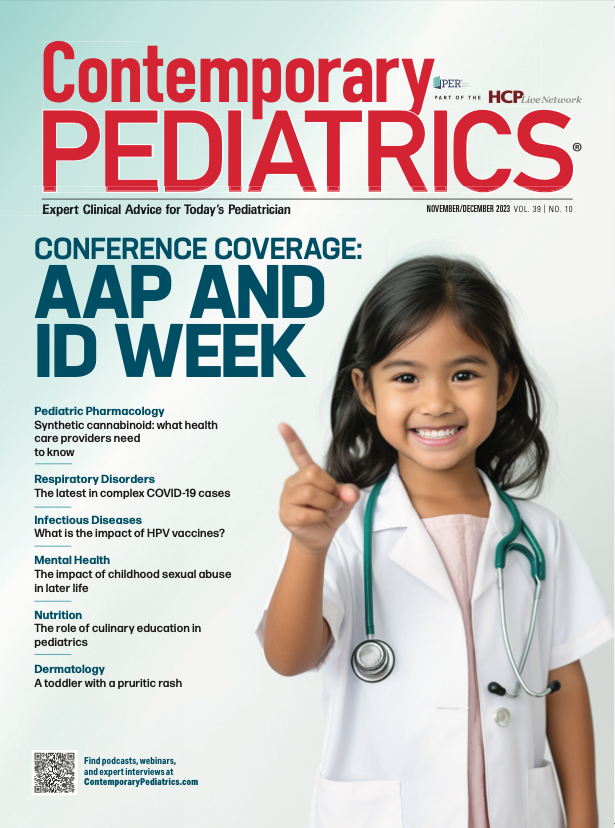Donna Hallas provides commentary on the latest issue of Contemporary Pediatrics
Donna Hallas, PhD, PPCNP-BC, CPNP, PMHS, FAANP, FAAN, offers her perspective on the latest articles from the November/December issue of Contemporary Pediatrics.

Research with adult survivors of childhood sexual abuse
Child abuse (physical abuse), neglect, emotional abuse, and sexual abuse, continue to be major threats to children in the United States and worldwide. The most recent statistic from the Centers for Disease Control and Prevention (CDC) reveals that at least 1 in 7 children have experienced child abuse or neglect within the last year.1 In 2020, 1,750 children died of abuse and neglect in the United States.1 The rates of child abuse and neglect for children living in poverty are 5 times greater than in children who do not live in poverty.1 The CDC reports that 1 in 4 girls and 1 in 13 boys in the United States are victims of sexual abuse in which 91% of these children experience abuse from a known and trusted family member.2 The CDC also reports that many children wait to report sexual abuse or never report being sexually abuse during childhood. Worldwide statistics are similarly concerning. Data from the World Health Organization (WHO) show that 300 million children between the ages of 2-to 4-years-old suffer physical and/or psychological violence from their parents or caregivers.3 In addition, per WHO data, 120 million females under 20-years-old have experienced forced sexual contact.3
New research study investigating adult survivors of sexual abuse
A report from a research study by Puri & Rao presented as a poster at the American Academy of Pediatrics (AAP) 2023 Annual Conference is briefly discussed in the November/December 2023 issue of Contemporary Pediatrics.4,5 Puri & Rao’s research study uses a 24-question, anonymous, online survey asking adults about their exposure to childhood sexual abuse.4,5 The researchers anticipated receiving 50 surveys but instead received 1,310 surveys from adult survivors of child sexual abuse.4,5 This research investigation may provide insights for prevention of child sexual abuse, early recognition of possible exposures to sexual abuse, and methods to communicate with the children and parents to increase provider awareness and prevention strategies.
Recognizing potential sexual abuse during annual examinations
As a former pediatric primary care nurse practitioner for children who were admitted to the Foster Care System, I am acutely aware of the emotional and physical trauma children experience due to all forms of child maltreatment and neglect, including sexual abuse. Young children carry these emotional traumas into their adolescent and young adult lives, and age out of the Foster Care system with internal, emotional scars of abuse. I have found that foster care children are resilient but that they can hide their traumatic emotional experiences deeply within their memory. Dedicated and intensive psychological therapy as well as support from foster care parents, while helpful, may not enable the child/adolescent to overcome the trauma. The question becomes, how can we, as health care providers, change the outcomes for children exposed to all forms of abuse, and the burden of hiding exposure to sexual abuse?
First, we must recognize that any child can be exposed to child abuse and maltreatment including sexual abuse. A terrifying example of parents not knowing that their children were being sexually abuse by a ‘trusted team doctor’ is the Larry Nassar sexual abuse case.6 The brave young women who stepped forward after enduring years of sexual abuse provided the details for pediatric health care providers to change practices, to ask each child privately about potential exposures to sexual abuse, and to make meaningful changes in the lives of all children through early recognition of potential sexual abuse. The questions all pediatric providers must ask of themselves include: 1) How comfortable am I in speaking with children about potential sexual abuse; 2) Do I ask age-appropriate questions about potential sexual abuse of each child during annual physical examinations; 3) Do I speak with parents to assure they are aware of ways to keep their children safe from sexual abuse?
Evidence-based research resources are available from the CDC on prevention of child abuse and neglect, sexual violence recognition, ACEs and implementation of the Resources for Action.2 All pediatric providers, educators, and parents can access these resources and play a major role in stopping child/adolescent sexual abuse.
References:
1. Centers for Disease Control and Prevention (CDC). Fast Facts: Preventing child abuse and neglect. National Center for Injury Prevention and Control, Division of Violence Prevention. April 6, 2022. Accessed December 19, 2023. https://www.cdc.gov/violenceprevention/childabuseandneglect/fastfact.html
2. Centers for Disease Control and Prevention (CDC). Fact Facts: Preventing child sexual abuse. National Center for Injury Prevention and Control, Division of Violence Prevention. April 6, 2022. Accessed December 19, 2023. https://www.cdc.gov/violenceprevention/childsexualabuse/fastfact.html
3. Child maltreatment. World Health Organization (WHO). December 19, 2022. Accessed December 19, 2023. https://www.who.int/news-room/fact-sheets/detail/child-maltreatment
4. Puri, VM, Rao, S. Experiences and perspectives of adult survivors. Poster presented at:2023 American Academy of Pediatrics National Conference & Exhibition; October 20-24: Washington, DC.
5. How childhood sexual abuse affects adult survivors. Contemporary Pediatrics: Mental health. December 1, 2023. Accessed December 19, 2023.https://cdn.sanity.io/files/0vv8moc6/contpeds/b0980f611e391a3414d19b7a36134e2cb5929c0d.pdf/CNTPED111223_ezine.pdf
6. Connor T, Fitzpatrick S. Gymnastics scandal: 8 times Larry Nassar could have been stopped. NBC News. January 5, 2018. Accessed December 20, 2023. https://www.nbcnews.com/news/us-news/gymnastics-scandal-8-times-larry-nassar-could-have-been-stopped-n841091

Newsletter
Access practical, evidence-based guidance to support better care for our youngest patients. Join our email list for the latest clinical updates.